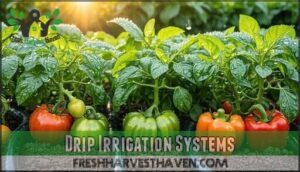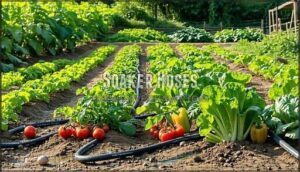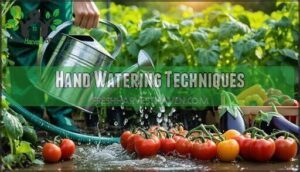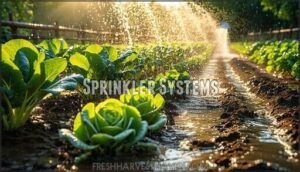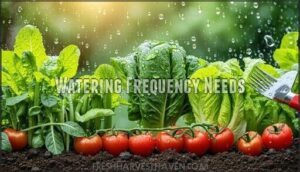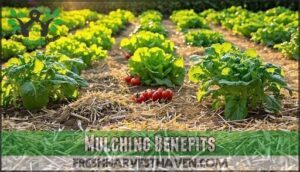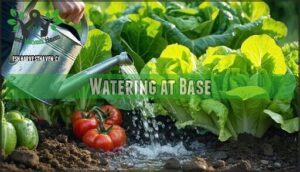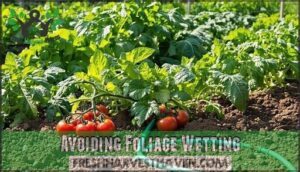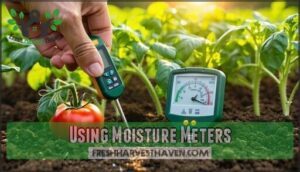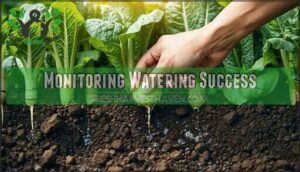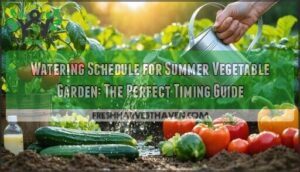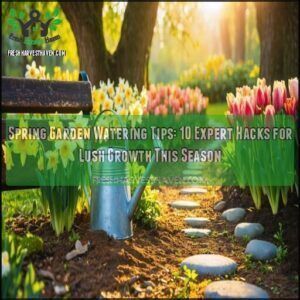This site is supported by our readers. We may earn a commission, at no cost to you, if you purchase through links.
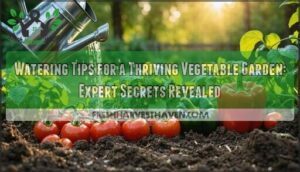 Master watering tips for a thriving vegetable garden by timing it right—water early morning when plants can drink deeply before heat arrives. Think of it like giving your garden a hearty breakfast.
Master watering tips for a thriving vegetable garden by timing it right—water early morning when plants can drink deeply before heat arrives. Think of it like giving your garden a hearty breakfast.
Water at the soil base, not the leaves, to prevent disease. Deep, less frequent watering beats shallow daily sprinkling every time.
Your tomatoes and peppers need consistent moisture, while lettuce prefers lighter, more frequent drinks.
Check soil moisture by sticking your finger two inches down—if it’s dry, it’s time to water. Mulch acts like a blanket, keeping moisture locked in longer.
Smart watering techniques can transform struggling plants into garden superstars.
Table Of Contents
- Key Takeaways
- Watering Timing Matters
- Choosing Watering Methods
- Watering Frequency Needs
- Effective Watering Techniques
- Monitoring Watering Success
- Frequently Asked Questions (FAQs)
- What is the most efficient way to water a vegetable garden?
- How long should I run my sprinklers on my vegetable garden?
- What is the best time to carry out watering in vegetable garden?
- How to properly water your vegetable garden?
- Should I water my vegetable garden every morning?
- How often should I water raise my vegetable garden?
- How to water vegetables during extreme heat waves?
- Can rainwater affect my gardens watering schedule?
- What vegetables need less water than others?
- Should watering change during flowering and fruiting stages?
- Conclusion
Key Takeaways
- Water early in the morning between 6-10 AM – You’ll reduce evaporation by up to 50% and give plants time to dry before evening, preventing fungal diseases that thrive in overnight moisture.
- Apply water directly to the soil, not leaves – You’ll avoid disease problems and ensure water reaches roots where it’s needed most, using drip irrigation or soaker hoses for targeted delivery.
- Water deeply but less frequently – You’ll build stronger root systems that extend 6-8 inches deep by watering thoroughly twice weekly instead of daily shallow sprinkling that creates weak surface roots.
- Check soil moisture before watering – You’ll prevent both overwatering and underwatering by sticking your finger 2-3 inches into the soil—if it’s dry, it’s time to water; if it’s moist, wait another day.
Watering Timing Matters
You can’t just water your vegetables whenever you remember—timing makes the difference between a bumper crop and struggling plants.
Water early in the morning or late afternoon when temperatures are cooler, and your plants will absorb more moisture while losing less to evaporation.
Smart timing beats guessing—water when it’s cool and watch your garden thrive effortlessly.
Morning Watering Benefits
With morning’s cool embrace, your vegetable garden receives ideal hydration that sets the stage for thriving plants.
Evaporation Reduction becomes your secret weapon when you water between 6-10 AM, as cooler temperatures lock moisture into the soil rather than losing it to the atmosphere.
Water your vegetables between 6-10 AM when cool temperatures lock in moisture and prevent wasteful evaporation.
This strategic timing promotes Disease Prevention by allowing foliage to dry completely before evening humidity arrives.
Your plants achieve superior Water Absorption during these cool hours, supporting robust Root Health and enhancing overall Plant Vigor throughout the day’s heat.
Avoiding Evening Watering
Watering your vegetable garden in the evening sets up a disaster waiting to happen.
When leaves stay wet overnight, you’re rolling out the red carpet for fungal diseases and pest attraction. Cool soil temperature slows evaporation, keeping leaf wetness around much longer than nature intended.
Here’s why evening watering backfires:
- Fungal diseases flourish in prolonged moisture conditions
- Root suffocation occurs when waterlogged soil lacks oxygen
- Pest attraction increases with damp, cool conditions
Smart watering vegetables means timing matters. Stick to morning watering tips for healthier plants and better watering frequency results.
Deep Infrequent Watering
Your plants crave consistency, not daily sips. Watering deeply twice weekly builds strong root development that reaches 6-8 inches down, creating impressive drought tolerance.
Deep watering twice weekly creates drought-resistant roots that laugh at summer heat waves.
This watering frequency promotes superior plant health through efficient water conservation and complete soil saturation. To confirm adequate hydration, use the finger test method to assess soil moisture.
Skip the daily sprinkles that create wimpy surface roots. Instead, focus on watering deeply using proven watering techniques that encourage robust root growth in your vegetable garden watering routine.
Choosing Watering Methods
You’ll find several effective watering methods for your vegetable garden, each with unique benefits that can transform your growing success.
The right watering system depends on your garden size, budget, and how much time you want to spend maintaining healthy, productive plants.
Drip Irrigation Systems
Your vegetable garden deserves precision watering that drip irrigation systems deliver straight to plant roots. These game-changing garden irrigation systems slash water waste by 50% while boosting plant health through targeted hydration.
System installation starts simple with modern kits containing pre-punched tubing, pressure regulators, and timers. Water pressure stays consistent with built-in regulators, preventing emitter damage and ensuring uniform distribution. Choose emitter types based on your plants’ thirst levels—1-gallon-per-hour emitters work perfectly for tomatoes, while 2-gallon options suit water-hungry squash.
Smart automation options let you set watering schedules and forget about daily chores. Your vegetables get consistent soil moisture without your constant attention. Consider using complete irrigation sets for easier setup.
Transform your garden with drip irrigation benefits:
- Freedom from daily watering stress – set timers and relax
- Healthier plants – roots develop deeper, stronger systems
- Lower water bills – precision watering cuts costs dramatically
Maintenance tips include monthly line flushing and checking for clogs. This vegetable garden watering technique turns novice gardeners into watering pros, delivering professional results with minimal effort.
Soaker Hoses
Soaker hoses act like underground rivers for your vegetable garden, delivering steady moisture exactly where roots need it most.
Soaker Hose Placement requires weaving them 6-12 inches from plant stems, creating efficient garden irrigation patterns.
Keep sections under 100 feet to maintain proper Water Pressure Regulation—longer runs lose effectiveness quickly. Hose Material Durability matters substantially; choose recycled rubber over cheap vinyl that cracks easily.
Position hoses before planting to avoid Garden Layout Impact issues later. Clogging Prevention starts with filtered water and annual flushing.
Many gardeners find reliable soaker hoses are essential for efficient watering. These garden watering tips deliver soil moisture directly to roots, reducing water waste by 50% compared to overhead sprinklers while preventing leaf diseases.
Hand Watering Techniques
Your hands-on approach gives you complete control over your vegetable garden’s hydration needs. Watering cans and hose length considerations make plant watering techniques simple yet effective. Nozzle types determine water volume delivery, while ergonomics prevents fatigue during longer sessions.
- Choose lightweight watering can designs for comfort
- Select adjustable nozzle types for different plants
- Control water volume with thumb pressure
- Position yourself close to minimize hose length
- Water slowly to prevent soil splash
Sprinkler Systems
Three major sprinkler types can transform your vegetable garden’s watering schedule into a hands-off operation.
Automatic irrigation systems offer wide coverage that’s perfect when you’re managing multiple beds, though water pressure and installation costs vary substantially between models.
Smart zone planning prevents those frustrating dry spots while maximizing your garden water management efficiency.
You’ll want to run your sprinkler system during morning hours to avoid disease issues that plague overhead watering methods.
To further improve efficiency, consider drip irrigation systems for targeted watering.
Regular system maintenance keeps everything running smoothly – clean those clogged nozzles and check spray patterns monthly.
Consider these irrigation systems benefits:
- Programmable timers maintain consistent watering even when you’re traveling
- Adjustable spray patterns target specific vegetable garden zones precisely
- Wide coverage area waters multiple beds simultaneously, saving time
- Cost-effective operation compared to daily hand watering labor
- Easy retrofitting adapts to your existing garden layout without major changes
Watering Frequency Needs
You’ll find that different vegetables have unique water needs, and your garden’s success depends on matching your watering schedule to these specific requirements.
Understanding how your soil type, local climate, and seasonal changes affect water demand helps you create a watering routine that keeps your plants healthy without wasting water, by considering the complete concepts of water management.
Vegetable Water Requirements
Understanding your vegetable water needs prevents both drought stress and overwatering disasters.
Root Vegetable Watering requires consistent moisture to prevent splitting, while Leafy Green Hydration demands steady water for tender growth.
Fruiting Plant Needs vary substantially – tomatoes and peppers need deep watering during fruit development, but beans and cucumbers require constant moisture throughout their growing season.
Dormant Vegetable Watering decreases substantially during winter months.
Achieving proper Soil Moisture Balance means providing 1-1.5 inches weekly through targeted watering tips.
Many gardeners also find that using mulch for moisture retention is highly effective.
Soil Type Considerations
Your soil type acts like your garden’s personality—it dictates how often you’ll need to water.
Sandy soil drains faster than a broken faucet, demanding attention every 2-3 days.
Clay soil holds water like a treasure chest, staying moist for 4-5 days.
Loamy soil hits the sweet spot with 3-4 day intervals.
Understanding your soil is key, so you can avoid costly mistakes.
Proper soil assessment helps identify areas prone to pooling.
Here’s your soil drainage cheat sheet:
- Test sandy soil moisture daily during hot spells
- Check clay soil deeper since surface dries first
- Loamy soil offers the most forgiving watering schedule
- Add soil amendments like compost to improve retention
- Match your drainage needs to your specific soil composition
Climate Factors
Beyond your garden’s borders, weather shapes every watering decision you’ll make.
Temperature Impact drives evaporation rates – hot days steal moisture faster than cool ones.
Humidity Levels work as nature’s thermostat, with dry air pulling water from soil while humid conditions slow moisture loss.
Rainfall Patterns throughout your growing season determine when you’ll need to step in.
Track weekly totals because an inch of natural irrigation beats any sprinkler system.
Seasonal Changes require weather monitoring and constant adjustments.
Spring’s cool soil needs less water than summer’s baking heat.
Microclimates within your yard create different zones – that sunny corner by the fence needs more attention than shaded areas.
Weather-based adjustments aren’t optional; they’re essential for thriving vegetables.
Adjusting Watering Schedules
Throughout your vegetable garden care journey, you’ll discover that watering schedules aren’t set in stone. Seasonal adjustments become second nature as you tune into your plants’ changing needs. Growth stage matters more than calendar dates—seedlings demand daily attention while established tomatoes thrive with deeper, less frequent drinks.
Weather monitoring transforms you into a garden detective, tracking rainfall patterns and adjusting accordingly. Different plant variety requirements mean your lettuce needs consistent moisture while your peppers prefer slightly drier conditions between waterings.
Consider these seasonal watering essentials:
- Spring awakening: Gradually increase frequency as soil warms and growth accelerates
- Summer intensity: Monitor soil moisture daily during heat waves and drought periods
- Fall shift: Reduce watering as temperatures drop and plant growth naturally slows
- Weather watching: Use rain gauges to supplement natural irrigation intelligently
Effective Watering Techniques
You’ve learned when to water your vegetable garden, but mastering how you water makes the real difference in plant health and harvest success.
Smart watering techniques like mulching, directing water to plant bases, and using moisture meters will transform your garden from surviving to thriving.
Mulching Benefits
Smart gardeners know that mulch isn’t just decoration—it’s your secret weapon for cutting watering time in half.
This protective blanket works around the clock, creating perfect growing conditions while you sleep. A 2-3 inch layer of organic matter transforms your vegetable patch into a water-wise powerhouse.
Here’s what mulch delivers for your garden:
- Evaporation Reduction – Cuts water loss by 60-70%, keeping soil moisture levels steady
- Weed Suppression – Blocks unwanted plants from stealing water and nutrients from your vegetables
- Soil Temperature regulation prevents root stress during hot summer days
- Nutrient Retention improves as organic mulch breaks down, feeding your plants naturally
Choose straw, grass clippings, or shredded leaves for maximum pest control benefits.
Watering at Base
While mulch works its magic above ground, Root Zone Hydration happens where it counts most—directly at your plant’s base.
Targeted Water Placement delivers moisture straight to hungry plant roots, promoting Efficient Absorption while Reducing Leaf Disease risks.
| Watering Method | Root Benefits |
|---|---|
| Drip irrigation | Deep watering depth penetration |
| Soaker hoses | Consistent soil moisture delivery |
| Hand watering | Precise garden watering control |
This watering techniques optimization prevents Avoiding Runoff while maximizing every precious drop.
Avoiding Foliage Wetting
While you’re mastering targeted watering at the base, keeping water off your vegetable leaves becomes your next defense against plant diseases.
Wet foliage invites fungal diseases that can wipe out your entire harvest faster than you’d expect. Water droplets sitting on leaves create perfect conditions for foliar diseases to develop and spread. When you accidentally spray leaves, those droplets can also cause leaf burn by magnifying sunlight. High water pressure makes this worse by forcing water onto foliage and splashing contaminated soil particles upward.
A key step is to avoid delayed harvesting issues which can increase pest and disease problems.
Here are proven watering methods to protect your plants:
- Direct water flow using drip irrigation or soaker hoses for precise soil-only watering
- Adjust water pressure to gentle levels that won’t splash or spray leaves
- Maintain proper air circulation by spacing plants adequately for faster drying
- Install mulch barriers to prevent soil particles from splashing onto lower foliage
- Choose morning watering so accidental moisture evaporates quickly before nightfall
These watering techniques keep your vegetables healthy and disease-free.
Using Moisture Meters
When you’re tired of guessing whether your vegetables need water, moisture meters become your garden’s best friend. These tools measure soil moisture content directly at placement depth where roots matter most.
Different meter types offer varying meter accuracy levels. Digital versions provide precise readings, while analog models use simple needle displays. Consider available product options before making a purchase.
Most require calibration needs before first use. Check reading frequency daily during growing season. Insert the probe 3-4 inches deep near plant roots, wait for stable readings, then clean thoroughly.
| Meter Type | Best Soil | Reading Time | Accuracy | Cost Range |
|---|---|---|---|---|
| Digital | All types | 10-30 seconds | High | $15-50 |
| Analog | Sandy/loam | 15-45 seconds | Moderate | $5-20 |
| Tensiometer | Clay/dense | 1-2 minutes | Highest | $30-100 |
| Multi-probe | Variable | 20-60 seconds | High | $25-75 |
| Smart sensor | All types | Instant | Variable | $40-150 |
Monitoring Watering Success
You’ll know your watering efforts are working when you check the soil moisture at root depth and watch for healthy plant growth.
Look for signs like firm leaves, steady growth, and soil that feels moist but not soggy when you stick your finger into it.
Soil Moisture Checks
Checking soil moisture levels beats guessing every time.
The Soil Feel Test works best—stick your finger 2-3 inches deep around plants.
Dry soil means it’s watering time.
Moisture Meter Use gives precise readings at different depths, especially helpful for understanding Root Depth Check needs and Assessing Drainage patterns.
Soil moisture content varies based on several factors:
- Container moisture evaporates faster than ground soil
- Sandy soils drain quickly while clay retains water longer
- Morning checks provide most accurate soil moisture levels
- Wilting Indicators appear before severe soil drying occurs
Your finger meter beats expensive gadgets for reliability.
To avoid moisture loss, remember to apply organic mulch effectively.
Visual Cues
Beyond checking soil moisture, your plants speak volumes through their appearance.
Drooping leaves in cool mornings scream dehydration, while yellowing leaves suggest overwatering.
Notice soil cracking around your vegetables? That’s drought stress talking.
Stunted growth and blossom end rot on tomatoes reveal inconsistent watering.
These plant symptoms guide smarter irrigation decisions than guesswork ever could.
Troubleshooting Watering Issues
When visual cues signal trouble, identifying the root cause keeps your garden healthy. Wilting causes range from bone-dry soil to waterlogged roots that can’t breathe. Yellowing leaves often point to overwatering, especially when soil feels soggy. Root rot develops quickly in constantly wet conditions, turning healthy white roots into black, mushy disasters.
Water toxicity from softened or chemically treated water can poison plants gradually. Shallow roots result from frequent light watering instead of deep, thorough sessions.
Watch for these warning signs:
- Black, foul-smelling roots indicate advanced root rot
- Overwatering vegetables causes stunted growth and pale foliage
- Underwatering vegetables produces crispy leaf edges and wilting
- White mold on soil surface reveals excess moisture
- Hard, cracked soil shows chronic drought stress.
Quick diagnosis prevents small problems from becoming garden catastrophes.
Adjusting Watering Strategies
Throughout the growing season, your vegetable gardening success hinges on smart watering adjustments.
Seasonal adjustments matter – spring seedlings need daily moisture while summer crops prefer deep, twice-weekly sessions.
Monitor weather patterns and reduce watering during rainy spells to prevent root rot.
Each plant type has unique needs: lettuce craves consistent moisture while tomatoes tolerate slight drying between waterings.
Check soil drainage regularly and modify your plant watering schedule accordingly.
Weather-based adjustments and consistent plant monitoring help you fine-tune techniques.
Different growth stages demand flexibility – flowering vegetables need more water than dormant plants.
Frequently Asked Questions (FAQs)
What is the most efficient way to water a vegetable garden?
Drip irrigation is absolutely revolutionary for vegetable gardens.
Install soaker hoses or drip lines to deliver water directly to roots, minimizing evaporation and disease.
Water deeply twice weekly rather than daily shallow watering.
How long should I run my sprinklers on my vegetable garden?
Run your sprinklers for 20-30 minutes, delivering about one inch of water weekly.
Check soil moisture by inserting your finger two inches deep—if it’s dry, you’ll need more time to reach proper saturation.
What is the best time to carry out watering in vegetable garden?
Water your vegetable garden early morning, ideally between 6-8 AM.
This timing allows plants to absorb moisture before day’s heat, reduces evaporation loss, and lets foliage dry completely, preventing fungal diseases.
How to properly water your vegetable garden?
Ever wonder how to keep your veggies happy?
Water deeply in the morning, aiming for soil-level hydration.
Let soil slightly dry between sessions, avoid wet leaves, and use mulch to lock in moisture.
Should I water my vegetable garden every morning?
Morning watering isn’t always necessary for your vegetable garden.
Check soil moisture first by inserting your finger one inch deep. If it’s dry, water thoroughly.
Most vegetables need deep watering 2-3 times weekly.
How often should I water raise my vegetable garden?
You should water raised vegetable gardens deeply 2-3 times a week, adjusting for weather.
Check soil moisture by touch; if it’s dry 1-2 inches down, it’s time to water.
Avoid shallow, frequent watering.
How to water vegetables during extreme heat waves?
During scorching heat waves, you’ll need to double your watering frequency and apply water early morning or late evening.
Focus on deep, thorough watering at soil level, and consider adding extra mulch for protection.
Can rainwater affect my gardens watering schedule?
Like nature’s own irrigation system, rainwater absolutely impacts your watering schedule.
You’ll need less supplemental watering since it’s chemical-free and penetrates soil deeply.
Adjust frequency based on rainfall amounts and soil moisture levels.
What vegetables need less water than others?
Onions, parsnips, and garlic thrive with minimal water, actually developing better flavor and storage quality when kept drier.
These root vegetables prefer less frequent watering compared to thirsty crops like tomatoes.
Should watering change during flowering and fruiting stages?
Tomatoes developing fruit need steady moisture to prevent blossom end rot and cracking.
Yes, you’ll adjust watering during these critical stages—increase frequency for flowering plants and maintain consistent moisture for fruiting vegetables.
Conclusion
Mastering these watering tips for a thriving vegetable garden transforms your growing success.
You’ll save time, conserve water, and boost your harvest yields substantially. Remember to water early mornings, target the soil base, and check moisture levels regularly.
Your plants will reward consistent care with healthier growth and better production. Apply mulch, adjust for different vegetables’ needs, and monitor your garden’s response.
With these proven techniques, you’re equipped to create the productive vegetable garden you’ve always wanted.
- https://www.almanac.com/when-water-your-vegetable-garden-watering-chart
- https://www.rhs.org.uk/vegetables/watering
- https://www.thrivelot.com/resources/ultimate-guide-to-soil-moisture-retention-for-edible-landscaping
- https://www.lostcoastplanttherapy.com/blogs/news/vegetable-garden?srsltid=AfmBOors5YiOw3PCEBaRhNqilt84rAofqocNcrvcBPMw8w1rHjxjZa5J
- https://aggie-horticulture.tamu.edu/earthkind/drought/efficient-use-of-water-in-the-garden-and-landscape/

